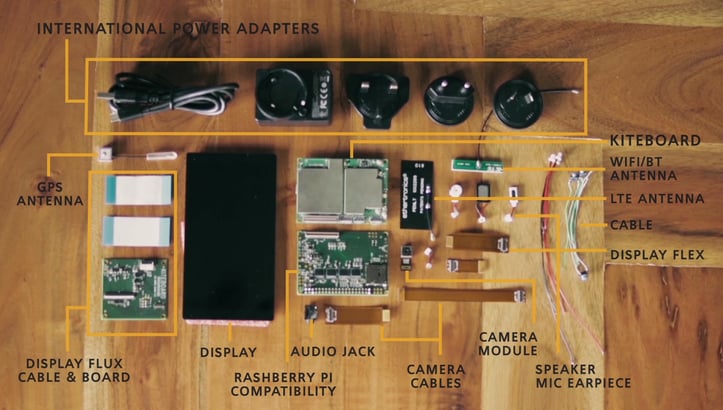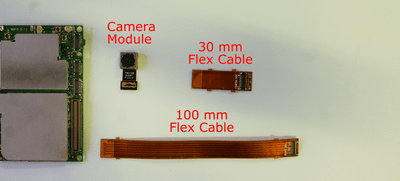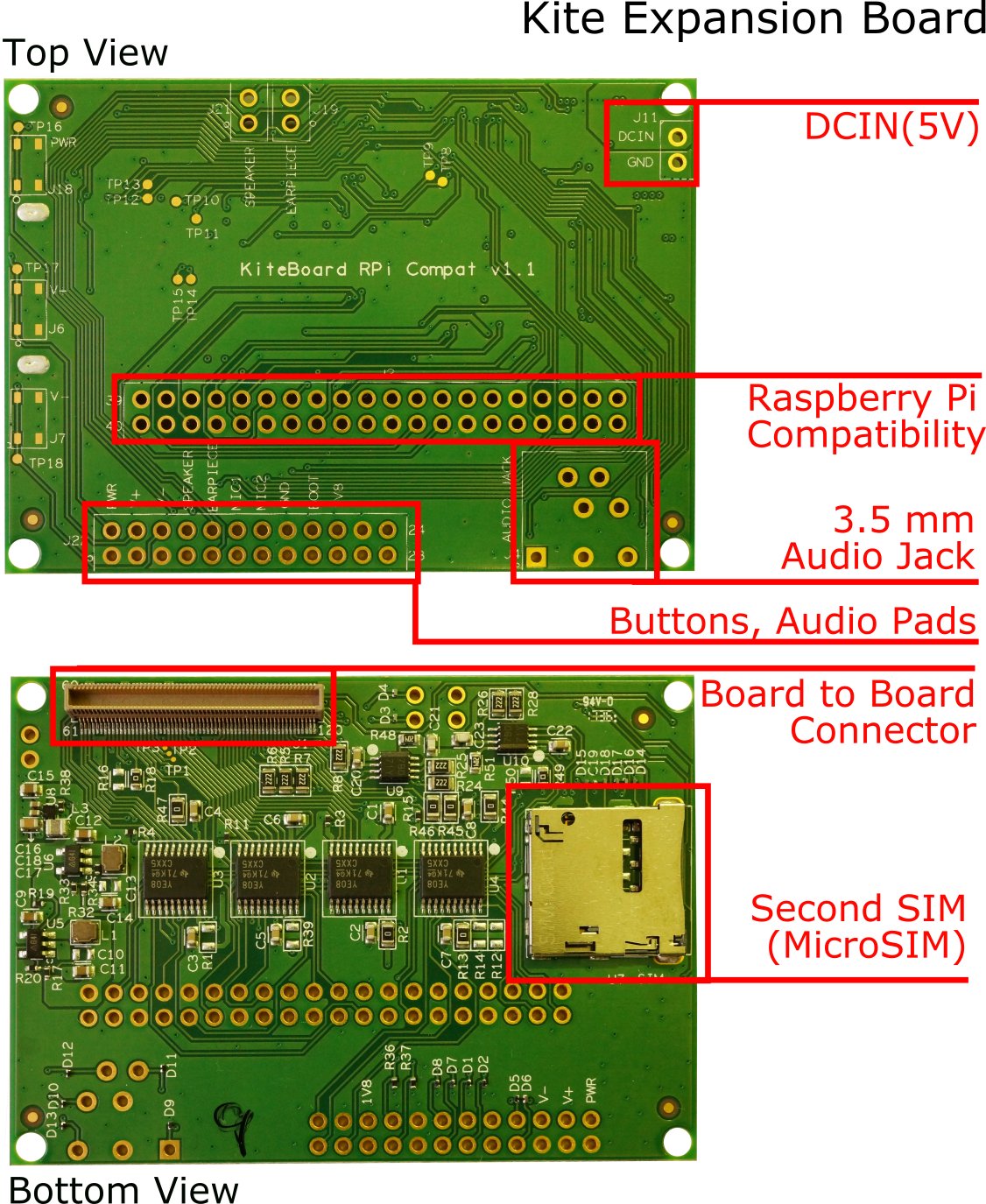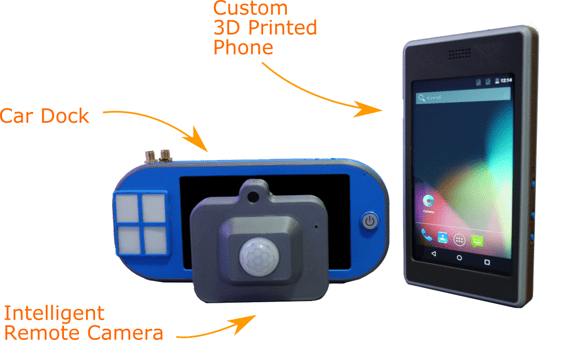Kiteboard is a single board computer that is best understood as the “motherboard” of a modern smartphone. A comprehensive kit empowers everyone to build custom mobile devices of all types.
Such custom devices can build on the capabilities of a modern smartphone platform: rich multimedia & connectivity, ample processing power & location awareness. Additionally, custom devices can differentiate themselves by including unique electronics, sensors and peripherals, a battery sized appropriately, plus antennas specific to the application.
To make it easy to build devices, we are coming out with a comprehensive kit, pictured below:

The KiteBoard may be powered using the international power adapter, with the 5V DC cable. The power adapter is rated for 2A, which is sufficient power to run the board with the complete kit (i.e. complete connectivity options, plus display). The USB cable can be used to connect to a PC for development/debugging purposes. Powering the board with just the USB cable is possible too, however – using the DC cable is recommended for better performance. If both the USB & the DC cable are connected simultaneously, then power is drawn from the DC power input.
To use the various connectivity options of Kite, you need to attach the appropriate antennas. Kite includes u.FL/IPX connectors on the board. This allows users to plug in a wide variety of off-the-shelf antennas from various vendors to the board. Off-the-shelf u.FL to SMA connectors may be used to connect an external antenna to the board.
For 4G/3G/2G connectivity (with a SIM card), we provide a penta-band antenna that works with all the RF bands supported by the board. To use WiFi/BT, you will need to connect the included WiFi/BT antenna. The kit also includes a small ceramic GPS antenna – getting your location quickly just becomes a breeze.
 The kit includes an 8 MP camera module, plus a couple of flex cables specific to the camera. The camera may be connected to the board in a few ways:
The kit includes an 8 MP camera module, plus a couple of flex cables specific to the camera. The camera may be connected to the board in a few ways:
- Plugged directly into the board.
- Connected to the board using the short (3cm) or long (10cm) camera flex cable. This allows positioning the camera as required for an application.
- The flex cables can be chained to get a longer distance (13 cm)
The good thing about this camera is that it can focus on objects. This has many uses, apart from clicking selfies.
A compact 5” 720p display module is one of the highlights of the kit. This incredibly bright (700 nits) display supports 5 finger touch operation. It is the ideal display to make your prototypes stand out. The display module is connected to the KiteBoard using an intermediate display adapter board. The display adapter board connects to Kite with another flex cable.

KiteBoard is a low power board; it operates at a voltage level 1.8V. This is different from many commonly available sensors and components, which operate at 3.3V or 5V levels. To make it easy to use off-the-shelt components, the kit includes an expansion board that breaks out the low speed interfaces (UART/I2C/SPI/GPIO), does the level conversion, and makes them accessible to the user. Not just that, it provides compatibility with the Rasperry Pi HAT connector! The expansion provides 5V, 3.3V power and all the IOs you need. Interfacing LEDs, buttons & sensors is a breeze. Also, you can use many of the widely available HATs and pHATs with Kite!
Note that the expansion board breaks out audio interfaces onto user friendly 0.1” pads. The included speaker, mic and earpiece which can be directly wired to these (these are similar to what you would find on consumer phones & tablets). The expansion board also includes the footprint of a 3.5” audio jack. An audio jack is supplied with the kit – this can either be mounted on the footprint, or connected using wires for flexible positioning.
The expansion board has the same size as the KiteBoard. It stacks neatly on top of the KiteBoard, connecting to it with a board-to-board connector with a stacking height of 4 mm. The resulting arrangement is quite compact, while providing you complete functionality.
The expansion board includes additional 0.1” spaced pads that expose functionality unique to Kite:
- Power, volume up and volume down buttons
- DC input (5V). This can be used to power the board, instead of the DC jack on the board.
- 1.8V power output
- Additional GPIOs at 1.8V level
- Boot configuration pins for future usage.
Last (but not the least), the expansion board allows you to use a second SIM card with the board ! KiteBoard implements a dual-sim, dual standby scheme - commonly available in many commercial phones.
The compact components of the kit empower you to create final prototypes with just the components in the kit. The secret sauce? 3D printing, of course! We provide ready to use, easy to print device designs, so a consumer grade 3D printer will do just fine. If you have a printer that can print multiple materials together, then even better!
The kit comes with the required files for 3D printing, and you can build devices like these with it:

Excited? Want to get your hands on the kit? We will be on Kickstarter soon – and we will have attractive early bird discounts. Please register at http://www.kiteboard.io/contact - and we will keep you informed about all the important stuff, including when we launch!
To bring this project to life, we need backers, lots of them! Know a friend or a colleague, or a whole group of people who would want this? Feel free to share… please help spread the word!
If you have any questions or comments, please let us know below -- we'll be happy to answer them...


Leave a comment here